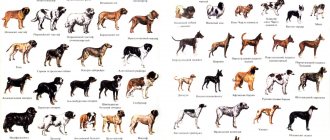Breed characteristics
| Short description | |
| Origin: | Germany |
| Conditions of detention: | House with garden |
| Purpose: | Companion dog, hunting dog |
| Color: | Silver gray, mouse gray, brownish gray |
| Wool length: | For short-haired dogs 1-2 cm, for long-haired dogs – 3-5 cm |
| Adult dog size: | The height of females is 57 - 65 cm, males 59 - 70 cm, weight of males is approximately 30 - 40 kg, females - 25-35 kg. |
| Average life expectancy: | 10-12 years |
| Walk: | Frequent long walks |
| Need for physical | High physical activity needs (regular or daily exercise for more than 3 hours per day) |
| Fédération Cynologique Internationale (FIC) classification: | Group 7 cops; Section 1 Continental Pointers |
| Puppy price: | From 20 to 60 thousand rubles. |
Pros and cons of the breed
Before you get yourself a Weimaraner, you should consider the strengths and weaknesses of the breed:
| Characteristics | pros | Minuses |
| Shedding | Hair falls out rarely and in small quantities | |
| Care | Requires periodic brushing as well as standard procedures | |
| Contents in the apartment | More suitable for living in the courtyard of a private house | |
| Get along with children | Get along well with each other | |
| Friendship with other animals | Doesn't fit. The dog is a danger to other pets | |
| Security and guard qualities | Entrusted property is guarded with full responsibility | Not suitable as a security guard |
| Training | Understands the owner perfectly, loves to perform various tasks | |
| Physical exercise | Loves | |
| Agility | Fits |
The Weimar Pointer dog is perfect as a pet. You can also get such an individual if you want to raise a winner of sports competitions or exhibitions. However, representatives of the breed are completely unsuitable for guarding a private house or apartment.
History of the origin of the species
The origin of the Weimar cop goes back to ancient times. There are many legends about the origin of these dogs. The main reason is that King Louis IX of France, after his captivity in Egypt, brought with him a pack of gray dogs, the ancestors of the Weimaraner. Soon the nobility liked them.
The dogs were nicknamed “silver ghosts” for the incredible speed they developed while hunting. In addition to their professional mission - driving animals, Weimar cops became companions, accompanying wealthy people to receptions.
The breed received its name in honor of the German city in which it was bred . The official date of its appearance is considered to be 1896, when these dogs were first presented at the exhibition. The breed standard was established in 1925, but official recognition occurred only in 1944.
In the 50s of the 20th century in the United States, Weimaraners experienced a peak in popularity and became the favorite breed of President Dwight Eisenhower.
Distinctive features
The main characteristics of the Weimaraner's appearance are clearly stated in the breed standard:
- The head is small with a round nape. The muzzle is long, almost rectangular. The transition of the forehead to the bridge of the nose is not too obvious. The forehead is wide with a furrow where folds appear during concentration. Lips are pursed.
- The jaws are strong with strong white teeth. Scissor bite.
- The nose is large and classically shaped. The lobe is dark flesh color.
- The eyes are medium size, round. Oblique incision. Puppies' eye color is azure; in adults - amber.
- The ears are quite large and hanging. When alert, slightly turned forward.
- The tail is set low and covered with hair. At rest it is located below, in work it is horizontal and above.
- The paws are long and dry. The muscles are well defined.
- The body is sinewy and muscular. The ideal length to height ratio is 12:11. The chest is massive, but narrow, the back is straight. The stomach is tucked.
As for wool, there are two types of breed:
- Short-haired with close-lying hair without undercoat.
- Long-haired with soft wavy hair 3-5 cm long. The hair on the head is shorter, but the ears are decorated with a beautiful long fringe. On the tail there is a pendant in the form of a flag. There is practically no undercoat.
There are only 3 acceptable colors in the breed:
- Silver gray;
- Mouse;
- Gray-brownish.
Only small white markings on the chest and toes are acceptable. Brown and red spots are considered defects.
Description of the Weimaraner breed
Character
It’s hard to imagine a more loyal and friendly pet. The Weimaraner is completely unsuited to being alone, so he is always close to his owner’s family, to whom he is selflessly devoted.
They get along well with children and protect them.
The Weimaraner is a strong and athletic dog and needs to be kept busy with any active physical activity. Hunting is great for this. However, if the owner is not a hunter, then it is necessary to specifically provide the Weimaraner with sufficient physical activity.
Weimaraners are always cheerful and often fearless. Therefore, they should be taught about “urban” dangers - approaching cars, aggressive people, etc.
Weimaraners are considered an "easy to train" breed and often work in rescue teams.
However, if the Weimaraner had a difficult life situation and was physically punished, not given the opportunity to move actively, and also deprived of human contact, then this dog is unlikely to be friendly and trusting.
It is their affectionate and competent attitude that makes them such faithful human companions.
Weimaraner breed standard
The gray-blue shiny coat, regal appearance and intelligent amber eyes of the Weimaraner make it a desirable life partner for many people, and for hunters - a real and irreplaceable assistant.
The dog's bones are strong, the body is slightly elongated. Height 58 - 69 cm, weight - 25 kg - 41 kg. Body sizes are medium to large.
The coat is short and quite stiff, but smooth to the touch. The shades of gray and blue in the wool shimmer beautifully and form such a unique silvery background.
The neck is muscular and quite high. The tail is set high, most often docked at about a third of its length.
Description of the head
The muzzle is long, sometimes with an “aristocratic” hump.
The nose is “liver” in color.
The lips are also “liver” in color. The jaws are strong, the grip is powerful, the bite is scissor, the tongue should be inside the oral cavity.
The eyes are large, almond-shaped, wide. Eye color - amber or dark amber. Weimaraner puppies have light blue eyes.
The ears are narrow and high set, wide, long and hanging, their ends are rounded.
There is also a long-haired Weimaraner and a straight-haired Weimaraner, as well as a “blue” Weimaraner. All these are varieties of the breed.
Photo of an adult dog
Photos of puppies
Longhaired Weimaraner
Features of character and behavior
The Weimaraner is a kind, friendly dog. Representatives of this breed are fast and agile. But the character of each breed has its own pros and cons.
Advantages
- The first thing that distinguishes these dogs is selfless devotion and love for their owner. They are ready to follow him always and everywhere.
- If the owner is involved in hunting or sports , his pet will keep company in these activities.
- Weimar Cops are well suited for families with children. They patiently endure the pranks of little ones and enjoy playing with older children.
- These dogs get along quite easily with other animals . Although sometimes owners say that problems arose in the neighborhood with a cat or small rodents. Weimaraners have a highly developed prey instinct, which can awaken at any time, even if its working qualities are not used for hunting.
- When meeting unfamiliar people or animals, they behave warily, but not aggressively . Cops usually play friendly with familiar neighborhood dogs.
- Weimaraners are very intelligent and quick-witted dogs. They can easily be taught household tricks, for example, wiping their paws after entering the house. But there is a danger here - learning to open doors and latches will not be difficult for them.
Flaws
- If you don’t keep your pet busy with physical activity and games, then his cheerful disposition can take its toll on the home environment.
- Without proper socialization and training, the Weimaraner can develop into a problematic hyperactive dog.
- Despite his wary attitude towards strangers, he is not a watchman. At best, he will notify the arrival of a stranger by barking.
Video
* We invite you to watch a video about the Weimaraner . In fact, in front of you is a playlist in which you can select and watch any of 20 videos about a given dog breed by simply clicking on the button in the upper right corner of the window. In addition, the material contains quite a lot of photos. By looking at them you can find out what a Weimaraner looks like.
In this article:
|
Rate the material!
[Total votes: 2 Average: 5]
The Weimaraner is Germany's sleek and fast "Grey Ghost" beloved by hunters and pet owners for its friendliness, obedience and beauty. These dogs enjoy playing sports and also spending a lot of time with their owners.
The Weimaraner was originally designed to handle large game such as deer and bears. At first, the Silver Ghost was a very popular dog only in his native Germany. Today, these graceful but demanding dogs can still be found on hunting grounds, but are used more as pets if trained well.
Care and maintenance
The first thing you need to think about when buying a Weimaraner puppy is whether you can provide him with comfortable living conditions. This is an active dog of impressive size, and it will be cramped in a standard apartment.
Dogs of this breed, regardless of the length of their coat, have virtually no undercoat; it is strictly forbidden to keep them outdoors. Only an insulated room is considered suitable living conditions for a Weimaraner!
The only possible option is a house with a decent area and preferably a garden where the dog can frolic. Lack of activity and exercise will negatively affect the development and health of your pet.
For winter walks, you must purchase insulated clothing, otherwise a long walk may result in colds.
Daily care for a dog of this breed is not burdensome:
- clean eyes, teeth and ears as needed;
- claws, if they do not grind down on their own, should be trimmed once every 3-4 weeks;
- bathe once every few months if there is severe contamination.
Nutrition
The issue of proper nutrition for a pet of this breed is extremely important, since Weimar pointers are prone to food allergies and problems with intestinal function.
In puppies, from 1-1.5 months there is a transition from milk to food. The number of feedings at this time and up to 3 months is 6-7 times a day . Then there is a gradual reduction in food intake. By the end of the dog's first year of life, you need to switch to two meals a day.
You can feed your Weimaraner dry food or natural food. In any case, the dog’s diet should be complete and balanced. When choosing food, owners should give preference to high-quality, high-quality food with a good composition.
When choosing natural feeding, you should exclude a number of products from the animal’s diet:
- fatty and fried;
- sweet and flour;
- spices and smoked meats;
- thin and tubular bones;
- minced meat, especially pork;
- river fish;
- onions and grapes.
Healthy foods that veterinarians recommend including in your dog’s diet:
- lean dietary meat;
- poultry meat, if there is no allergic reaction to it;
- dairy products;
- heat-treated sea fish without bones;
- vegetables and fruits;
- cereals
Any type of nutrition requires the dog to have constant access to fresh, clean water. Veterinarians also advise taking a course of vitamins 1-2 times a year , especially with natural feeding.
For working dogs, food should not be too cold or hot, only at room temperature. Otherwise, you can kill their sense of smell.
Health
Weimar cops are characterized by good health . However, this does not negate preventive visits to the doctor and close attention to the pet’s condition.
Vaccinations
Dogs must be vaccinated on time. The first vaccination is given to puppies at 6-8 weeks , then at 12 weeks - revaccination. Next comes a comprehensive vaccine at 6-7 after changing teeth . At 12 months , the dog will receive the third set of vaccinations and a mandatory rabies vaccine.
Vaccination is done against plague, adenovirus, parainfluenza, enteritis, hepatitis, leptospirosis.
The choice of medications is now very wide (Biovac, Nobivak, Kanigen, Eurikan). The cost of one vaccination can vary from 200 to 2,500 rubles . Therefore, when choosing a product, it is better to consult with a veterinarian, who will tell you about the advantages and disadvantages of each of them and advise the best option for your Weimaraner pet.
To successfully complete the vaccination procedure:
- the dog must be absolutely healthy;
- the period of teeth change must end or not yet begin;
- External and internal parasites must be treated 10-14 days before vaccination.
Vaccination is prohibited if:
- 2 weeks left before giving birth, or the dog gave birth less than 2 weeks ago;
- the pet is recovering from a course of antibiotics;
- there is a postoperative period.
After vaccination, the dog may be lethargic for a couple of days - no need to worry, this is normal.
For the next 2 weeks, the owner must limit the pet’s physical activity and not take it out into large crowds of other animals. The dog's immune system will be weakened for some time after the vaccine.
Diseases
Each breed, no matter how healthy it is, has identified the diseases to which it is most susceptible. The Weimar cop has this:
- Pathology of joints . It can be either hereditary or acquired. If the disease is detected in a timely manner, its course can be stopped.
- Pathology of the spinal cord . Can lead to complete paralysis of the animal.
- Myasthenia gravis . A disease in which a dog loses control over muscle activity.
- Eye diseases. Weimaraners are susceptible to deformation of eyelashes, entropion of the eyelid, inflammation and atrophy of the cornea.
- Problems with the stomach and intestines. Most often, bloating and volvulus occur as a result of improper feeding of the dog.
- Tumors. Melanoma, fibrosarcoma, mastocytoma - all of this occurs in Weimar cops in adulthood.
- Cryptorchidism. When choosing a male puppy, especially a mature one, you need to pay attention to whether both testicles have descended into the scrotum.
To prevent the appearance and development of these diseases, it is recommended to take your dog for examination to an experienced veterinarian at least once every six months.
Walk
These dogs are essentially pointers. They have a high need for daily long walks with physical activity. They need to be given the opportunity to expend their frantic energy and run out. In this case, there will be no problems with pets, and the dog will not want to play with the sofa leg or shoes.
Weimaraners should only go for walks accompanied by their owner. The hunting instinct can force a dog to chase a passing cat at any moment. In pursuit, the dog forgets itself and may not notice a car or other danger awaiting it.
The ideal option is to take your pet to the forest or to a playground with plenty of equipment to play with . Frisbees, balls, and any other objects that you can run after are welcome. The dog will be captivated by such activities for hours.
Grooming
Grooming both short-haired and long-haired Weimaraners does not take much time . They do not shed because there is almost no undercoat. Brush them once a week. Short-haired - with a rubber brush, long-haired - with a brush with short teeth.
Caring for a Weimar Pointer
Weimaraners are kept both in private houses and in city apartments - both options have a right to exist. But the dog, of course, will love a country estate with a spacious walk, where you can run around to your heart’s content, and at least play hunting with random birds.
Nutrition
In Weimar pointer kennels, the dog diet is usually based on high-calorie, high-level ready-made food, for example, the following:
- Brit Care Endurance;
- Belcando Adult Active;
- Baskerville Active Dog;
- GO! Natural Daily Defense Lamb Dog Recipe;
- Acana Sport & Agility.
From the first feedings, dogs should receive only high-quality food
On the other hand, most hunters prefer natural feeding - in their opinion, freeze-dried food dulls the hunting instinct and motivation to prey. Most likely, this is just one of the canine myths, but a natural dog is really good for hunting dogs - the main thing is to organize a balanced menu and be sure to include the following products in it:
- lean meat, preferably frozen, with a small number of bones;
- poultry - without tubular bones;
- eggs;
- sour milk;
- vegetables fruits;
- grains - well-cooked rice and buckwheat.
Supplements with vitamins and minerals will also help, especially during the puppy's growing stage. But you absolutely cannot feed your dog from your table, just like treating it to anything from the following list:
- fatty, peppered and smoked;
- legumes and citrus fruits;
- sweets and fresh pastries.
Hygiene
Due to the undeveloped down, shedding in this breed goes almost unnoticed, and the coat does not require special care. Long-haired dogs usually need to be brushed a little more often than their short-haired counterparts, but a couple of times a week is enough for them. As for washing, many working dogs are not bathed at all - swimming in rivers and lakes while hunting is enough for them.
Weimaraners enjoy bathing in natural ponds
Regularly, at least once a month, clean your pet's teeth of plaque and trim his nails. Carefully monitor the condition of the eyes and ears - these are the weak links in the health of the Weimaraner: the ears often become inflamed, and the eyes are susceptible to some breed diseases that should be recognized as early as possible.
Walk
The more the Weimaraner walks, the better for everyone. The main behavioral problems of this breed are related precisely to the fact that the dog systematically does not realize its potential - physical, emotional, intellectual.
Outdoor games and sports exercises should be part of every walk
Immediately prepare for the fact that you will spend at least three hours walking every day. Even if you live in a private house, running back and forth across the yard will clearly not be enough for the dog - he needs contact and spending time together with a person, the ability to predict the owner’s wishes and commands.
When walking in the countryside, try to change the route more often so that the dog gets new impressions. But on noisy city streets, be sure to take the Weimaraner on a leash: suddenly a provoking factor may come into play, for example, the dog rushes headlong to catch crows - and gets lost or gets hit by a car.
Training
Working dogs have their own training system - it depends on the talents of a particular individual and on the tasks assigned to it. But if you are not a hunter and just want to have a beautiful and smart dog next to you, then this absolutely does not mean that you can not engage in upbringing and training.
Working preparation of cops is achieved through a special training course
Many people complain that Weimaraners are bad students. The point is not about dogs, but about the fact that you need to be able to work with them - to make training so that training becomes not a burden, but a joy. A smart cop will not, like a perfectionist shepherd dog, practice the same command day after day, bringing it to perfection. The Weimaraner considers this approach boring, stupid and uninteresting - he wants to quickly move on, craves new knowledge and skills. I wish I could find another trainer who understands this...
The specifics of training a Weimar cop include the following nuances:
- socialization of the puppy should begin very early - as soon as he is allowed to walk after the first vaccination and quarantine, this is approximately nine weeks of age;
- the child’s knowledge of the world and his place in it should be carried out in an unobtrusive playful form - Weimaraners mature quite late, and this also needs to be taken into account;
- the first and most important thing that a pet needs to learn is that it receives all the benefits of life from its owner, which means it must honor and unquestioningly obey the person;
- practicing the “package” of basic commands is also extremely important, but in the process you cannot put pressure on the dog and rush it, forceful methods will result in disobedience;
- if you are dealing with a dominant individual (and such are often found in the breed), then you will have to prove your right not to be superior and commanding.
There is no averaging - only an individual approach will work: you need to create a conditional “corridor”, on one side of which there is encouragement, and on the other - not, not punishment, but your dissatisfaction, disappointment or resentment. Dogs of this breed are sensitive to the mood of the owner and try to make the person happy with them.
A general training course is more than enough - and only with a good trainer who understands the breed. If there is none, then a loving owner with at least minimal experience is capable of raising his own dog. Weimaraners are not trained for protective guard duty, although, judging by messages on forums, someone is trying to use them as guards. But in some places in Europe, the talents of these dogs are already being successfully used by the police, customs and rescue services.
Video: everything about the Weimaraner dog breed
Mating
- For help in choosing a pair for your pet, it is better to contact experienced breeders. They will tell you what to look for when casting a future partner. The suitable age for mating an animal is from 1.5-2 years , not earlier. Bringing dogs over 7 years of age is strictly prohibited.
- Breeding Weimaraners has many pitfalls . For example, great care must be taken when crossing short-haired and long-haired varieties.
- At a kennel or dog club, professionals will tell you about all the difficulties of mating , pregnancy and childbirth, and will also help you go through these stages as painlessly as possible.
- It is better to introduce the dogs in advance on a neutral site, but mating takes place exclusively on the territory of the cable 11-14 days after the female starts estrus. After a day or two, a control mating is carried out to guarantee the result.
Key points in training
Weimaraners are very intelligent and quick-witted dogs. They are easy to train. The only difficulty the owner faces is stubbornness and attempts to dominate.
- Professionals advise conducting classes in a secluded place where nothing will distract the puppy from learning commands. Training is conducted in a playful manner without the use of physical force; a severe reprimand for disobedience is sufficient.
- You can organize training in pairs with an adult trained dog; the puppy will happily copy its behavior and remember commands more successfully.
- Read about how to properly train a dog in the article: “Training a puppy: effective methods from dog handlers, learning commands at home.”
Beginner dog owners are advised to take the course under the supervision of a professional instructor. When training a Weimaraner, patience, firmness and perseverance of the owner are important.
Training and education
Representatives of the breed are prone to dominance, so it is necessary to begin raising a puppy from the very first days of its appearance in the house. The Weimaraner can be stubborn and disobedient during training, so the owner needs to be patient and follow systematic training rules. It is also known that cops have a freedom-loving character. Therefore, professional breeders are confident that only experienced dog breeders should work with this type of dog.
During the learning process, it is recommended to start memorizing a new command only after previous lessons have been repeated. When the dog begins to obey its owner, you can take it to a special dog park to get acquainted with physical training.
How to choose a puppy
The breed is not very common in Russia, so there are practically no advertisements for the sale of puppies by hand. It is better to purchase a baby from a trusted nursery, which will give a guarantee of quality, show the pedigree, parents and offer several puppies to choose from.
There is no need to rush when buying . Meeting your future pet is a very exciting moment. You can observe how he behaves with other puppies, how he reacts to a new person. It is recommended to carefully examine the baby for the absence of obvious external defects.
- Show class puppies are the first in the litter and are intended for exhibition. Such puppies usually cost more than 30,000 rubles .
- Pet-class babies have no defects, but are considered slightly lower in quality and are sold as pets. Their cost starts from 20,000 rubles.
The final cost depends on the title of the kennel and the richness of the puppy’s pedigree.
But do not forget that not only heredity affects the development of a dog! Its further nutrition, maintenance and growth conditions for the pet are important.
Weimar Pointers are an elite breed of dog that combines keen intelligence, friendly qualities and hunting skills. It is suitable for outdoor enthusiasts, novice dog owners and families with children. But homebodies with limited living space should avoid choosing a Weimaraner puppy.
Diseases and health problems
Although Weimaraner dogs are healthy and strong, they can suffer from certain genetic problems. If you are considering getting a Weimaraner, it is important to have information about all aspects of the breed's life, including potential health problems that may arise.
The most common Weimaraner diseases include:
- Hip dysplasia. Individuals with hip dysplasia may or may not have any clinical signs. The disease is believed to be hereditary, with diet, rapid growth and environment contributing to the development of the disease;
- Bloat or volvulus is a life-threatening condition that can affect large dogs with large chests, especially if they eat a lot of food at one time, eat quickly, drink plenty of water, and exercise vigorously after eating;
- Von Willebrand disease (vWD) is an inherited blood disorder (poor blood clotting). The main symptom is excessive bleeding after injury or surgery;
- Entropion, a defect that usually appears around six months of age, causes the eyelid to move inward, injuring the eyeball;
- Factor XI deficiency is another bleeding disorder that is usually mild but can become severe after injury or surgery;
- Hypothyroidism is a deficiency of thyroid hormone and can cause infertility, obesity, mental dullness and lack of energy. The dog's fur may become rough and brittle and begin to fall out, and the skin may become rough and dark;
- Retinal atrophy (PRA) is a degenerative eye disease that causes blindness due to the loss of photoreceptors in the back of the eye;
- Some Weimaraner puppies react to vaccinations with fever, elevated white blood cell counts, and inflamed tissues and joints. Reactions occur most often between 12 and 16 weeks of age. The rabies vaccination can be given at 16 weeks of age.











